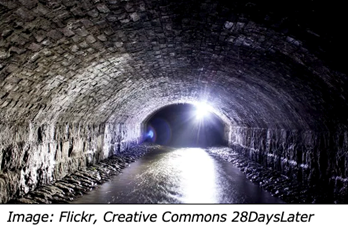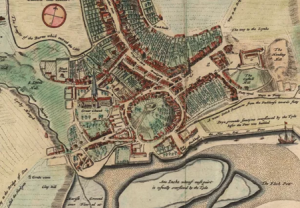As the map below shows, the centre of Aberdeen in the nineteenth century was very different from what it is today. A clue to the past came in the edition of the Press and Journal, the famous north-east morning newspaper, of Monday 1st April 1912, where they ran a report about what had been found when water was pumped out of a “curious, underground beehive-like chamber in St Paul Street.”
Upon clearing the chamber of water, the workmen entered what the P&J described as “a spacious, circular room about fifteen feet high, and with a similar diameter.”
This discovery came about because of work being done to convert a house in St Paul Street into a motor garage. Excavations uncovered a stone slab, measuring some 2 feet by 2 feet. When it was lifted, a large vaulted passage was exposed. This passage led to a brick-lined chamber, with clear evidence of water having made its way through the brick.
Archaeologists believe the chamber was used to store barley, which was then steeped in water to turn it into malt for making into whisky. However, malt also needs heat, and further investigations revealed that the ends of the passage would once have conducted smoke from the fire used to dry the malt.
The P&J article continues, “Documents in the possession of the proprietor of the house show that before 1744 it was in the possession of a mason, who may have made the underground works. It was afterwards owned by a merchant, and in 1822, when the duty on whisky was very high, by an officer of Excise.”
About 10 years later, the Press & Journal published another article, noting that,
“Architecturally, Aberdeen has buried much of its past, but it has failed to submerge it completely, so that citizens of today need no magic carpet or genie from Aladdin’s lamp to transport them back through the years.”
If you stroll through Carnegie’s Brae, off Netherkirkgate, there are signs of the town that existed many years ago. The celebrated Aberdeen architect, Archibald Simpson designed Market Street in the 1840s, leading to the creation the vaults and chambers that exist today. Union Street, built before this, was underpinned by tunnels and arches, many of which served as vaults for existing businesses but which are now filled in. Unfortunately, as far as we know, no-one is trying to make whisky below the city centre nowadays, although given that the pubs above ground all sell the many famous brands of Scotland’s national drink, there is no need for barley to be stored in the city centre vaults!
Julie Skinner, Resourcing and Benefits Specialist, RGU


